
Introduction – Nothing is More Dangerous than a Discreet Nazi
People have been digesting the appointment of Stephen Bannon as Trump’s chief strategist and the sudden rise in overt racism and Nazi symbology. There are people saying “Heil Trump”, giving Nazi salutes, and spray-painting swastikas in alarming numbers. The US is a large, populous, diverse country, but there is clearly something of significance here beyond just a few ignorant teenagers with spraycans and emotional issues.
The overt Nazism is very disturbing. It was less than reassuring when Anne Coulter sought to tweet some perspective “Rachel shows FIVE PEOPLE at Richard Spencer meeting giving a Nazi salute. Call out the National Guard. Cf. Ferguson protests.” Then minutes later: “Total # of deaths connected to American Nazi Party in last quarter century: ZERO; Total # of deaths connected to Al Sharpton: 9 I know of.” Coulter might have chosen to compare exaggerated notions of a Nazi threat with, say, road fatalities or shark attacks. Instead she specifically cites examples that will provoke a fear of black violence. Instead of reassuring us, she shows that the overt Nazis are just the tip of an iceberg of frightening racists that includes her.
Equally unreassuring were Trump’s attempts to convey cherubic innocence and naïve confusion. Regarding what NYT’s Maggie Haberman referred to as “alt-right supporters” he said: “It’s not a group I want to energize. And if they are energized I want to look into it and find out why.” For students of history this may be especially unnerving because Nazi and Fascist leaders deliberately cultivated ideological followers who could organise and carry out acts of violence which were deniable and which the leaders could, if it suited them, condemn as excessive.
[I should explain here that I use the term Nazi even though I would usually only refer to regimes and parties by the term’s they use to name themselves. In this case, however, I cannot be bothered with writing “National Socialist” each time because nobody else does.]
But Nazis who openly wear swastikas are not and never have been the real threat in Western countries. For decades thinkers have warned us that fascism will come to the West in the guise of a return to normalcy (a claim that is actually part of the essence of fascism). The US is particularly scary because it tolerates and empowers fascism more than other Western countries. Trump, for example, won the votes of tens of millions after he had vowed to increase the use of torture and to murder the families of “terrorists”.
Trump has been given a gift, because he can choose to continue to embolden the street-thug Nazis or he can make a great show of rejecting and crushing them. He will probably do both simultaneously and by turns, but all the while the back-room Nazis, the crypto-fascists who don’t even think of themselves as fascistic, will grow in strength.
To get some perspective on how far the US has gone into overt and proud barbarity, take the example of Trump’s nomination of General James “Mad Dog” Mattis to the post of Secretary of Defense. To start with, there should be alarm bells ringing when the President elect is working a crowd at a victory rally by yelling “Mad Dog!” repeatedly. The most memorable of many quotes from Mattis may be: “Actually it’s quite fun to fight them, you know. It’s a hell of a hoot. It’s fun to shoot some people. I’ll be right up there with you. I like brawling. You go into Afghanistan, you got guys who slap women around for five years because they didn’t wear a veil. You know, guys like that ain’t got no manhood left anyway. So it’s a hell of a lot of fun to shoot them.”
Mad Dog got his sobriquet from his military service. Dahr Jamail was in Iraq during both 2004 battles in Fallujah conducted by Mattis. Jamail makes it very clear that Mattis is a war criminal:
During the April 2004 siege, more than 700 civilians were killed by the US military, according to Iraqi doctors in the city whom I interviewed in the aftermath of that attack.
While reporting from inside Fallujah during that siege, I personally witnessed women, children, elderly people and ambulances being targeted by US snipers under Mattis’ command. Needless to say, all of these are war crimes.
During the November siege of Fallujah later that same year, which I also covered first-hand, more than 5,000 Iraqi civilians were killed. Most were buried in mass graves in the aftermath of the siege.
Mosques were deliberately targeted by the US military, hospitals bombed, medical workers detained, ambulances shot at, cease-fires violated, media repressed, and the use of depleted uranium was widespread. All of these are, again, war crimes.
At that time I broke the story of the US military’s use of white phosphorous, an incendiary weapon similar to napalm in its ability to burn all the way down to the bone.
Mattis is openly antagonistic to Iran and to “political Islam”. This led to Congressional Representative Allen West (R, Florida) sharing a “meme” on Facebook which pictured Mattis and read: “Fired by Obama to please the Muslims, hired by Trump to exterminate them.” Before Facebook took down the post it gained 50,000 likes and 10,000 shares. This is not about a few bad apples. West’s career, his election and his 2.5 million Facebook followers all give us a window into what is really going on in the US.
West has said that “Islam is a totalitarian theocratic political ideology, it is not a religion. It has not been a religion since 622 AD, and we need to have individuals that stand up and say that.” In 2010 Jen Phillips wrote: “West equates today’s Muslims with those of medieval Europe, alleging that if Muslims in the US are not stopped, we too will have to change our name like Constantinople.” He is also a self-confessed and proud torturer. In Iraq Lt. Col. West watched on as four of his men beat an Iraqi policeman on the head and body. He dismissed his men and then staged a mock execution, threatening to kill the detainee and then firing his sidearm next to the blindfolded man’s head. Under US Army Field Manual The Law of Land Warfare such coercion is clearly defined as torture. The seriousness with which the US Army takes such laws can be judged from the result – West was fined $5000 and retired with full pension benefits. The seriousness with which US people regard the lives and rights of others is clearly reflected in West’s successful political career.
The problem with extremists like West is not that they are in the majority it is that they are an accepted part of the political spectrum. As I will discuss further, the same was true of anti-Semites in Germany before the holocaust. Trump only has a 41% approval rating, which is amazing for someone who has yet to take office, but it is hard to take seriously those who oppose him any more because they want to have their exceptionalist cake and eat it too.
If there were approval ratings polls in Germany in 1932, Hitler would have also been below 50%. He was a polarising figure, and most people did not vote for him. The reason that Mattis, West and Trump succeed is that their opponents seem more interested in feeling good about themselves than about doing what is right. Many of them supported Clinton who, as we will see, is also insupportable. If people are not willing to stand up against the chauvinistic arrogance of US patriotism and exceptionalism then their opposition to Trump’s fascism is empty in both moral and practical terms.
To understand what it all means, I am going to present it as a horror novel spanning a hundred year; one with a chilling twist in the tail. I am not meaning in any way to make light of things. I am doing this to highlight that this is an informed argument based on solid inference: a logical progression grounded in history.
Certain commentators such as “Tyler Durden” of ZeroHedge were certain that Trump and his coterie are really trying to “drain the swamp” and sweep away DC corruption and more. As one breathless fantasist explained:
Drain the Swamp pertains to more than getting the corruption out of the system.
Bannon now has Trump’s full backing to destroy the UniParty, defeat the Globalists, banish the warmongers of the MIC and help the legal prosecution of the corrupt. This is the Revolution to end the domestic Tyranny and the global Hegemon.
In contrast, the blithe self-righteous liberal stance of NYT and its ilk is just as speculative and just as ideological. Perhaps one of the most significant medium term impacts of the 2016 campaign is that print journalism has descended to Fox/MSNBC levels of inaccuracy, with NYT, Time and WaPo liberally putting words in Trump’s mouth and making ludicrous claims about his ties to the Kremlin. This means that they have broken with generations of journalistic practice and the “North Korea Law of Journalism” (“editorial standards are inversely proportional to a country’s enemy status”) by telling barefaced lies about domestic politics when they normally only tell barefaced lies in international stories. Such lies are not the biggest problem though. The real problem is that the respectable media will selectively treat some utterances of Western politicians as being unquestionable truth. The result is a very distorted narrative, but we do not notice how irrational and fantastical it is because it is made banal by constant repetition.
To illustrate my point, if we take the ranting of the alt-right “revolutionary” above, once you look past the exotic terminology, the basic flaw in reasoning is that this person trusts Trump, a lying billionaire showman/fraudster with a proven record of betraying and fleecing anyone he can. You have to be very selective in your memory to think that Trump is going to oppose the growing corruption and concentration of wealth and power in DC, in the US, and in the world. However, contrast this for a second with the perfectly orthodox claim that Clinton seeks to bring peace and stability to the Middle East through a no-fly zone or some other initiative. If you really step back from the assumptions that surround us, that is a truly insane statement. Firstly, Clinton’s track record on peace in the ME and North Africa (dating back to her role in backing the Iraq NFZ, sanctions and Operation Desert Fox decades ago) is even clearer than Trump’s record of honesty and straight-dealing. Secondly, the US itself – however often it protests benevolent intent – has been acting in ways that promote conflict and instability in the ME since at least 1979. The fruits of US intervention are extremely obvious and monotonously predictable, repeatedly saying that it will be different this time has long since surpassed mere credulity and entered the realms of dangerous mental dysfunction. Thirdly, though everyone seems to avoid seeing it, if this was a strategy computer game or board game it would be immediately obvious that the US benefits from the conflict it brings about in the MENA region. The obvious conclusion is that the US destabilises and sows conflict deliberately.
If you ask yourself how the US would behave if they were intentionally maintaining instability it would look exactly as it does, right down to the protestations of peaceful intent. Logically, therefore, it is less doolally to say that Trump is fighting the evil tentacles of the Illuminati New World Order than it is to say that the US is concerned over the suffering of civilians in Aleppo, wants to promote democracy in Iraq, seeks to restore stability and prosperity to Libya, or is genuinely concerned about Iran’s nuclear programme.
Luckily we do not have to rely on the things that pour forth from the orifices of politicians to make sense of events. When I say “luckily” I am using it in a special sense because once you strip away all of the illusions of Western benevolence the world is much bleaker and more alarming, but the longer we fail to face these realities, the worse things will become. This tale of horror I want to tell is a history of things going very badly for us all, and it did not begin in November 2016.
There are a number of places I could begin my tale, but I want to start as I mean to go on – with Nazis.
Chapter 1. Germany 1918-32 – A Paradise for Right Wing Violence
The violence and legalised illegality of Hitler’s Third Reich did not arise without precedent. Liberal and pluralistic Weimar Germany was, in fact, a very benign environment for proto-Nazi and Nazi violence. Social Democrat President Friedrich Ebert worked with the right-wing nationalist Freikorps militias to suppress a postwar socialist republic in Bavaria and socialist revolutionaries in the rest of the country. He would later retrospectively legalise the murders of thousands of leftists. This was one of 136 times he used “emergency powers” while President. Those same Freikorps carried the “Kapp Putsch” in 1920 which was not defeated by Ebert’s government, but by a mass popular uprising. Ebert’s successor Hindenburg was a conservative nationalist who also used emergency powers freely, including overriding the Reichstag. The judiciary throughout the Weimar period was unambiguously forgiving of right-wing political violence and repressive of the left. Most notably, a certain Adolf Hitler was given an extremely lenient sentence for his failed attempt at an armed putsch, turning what should have been a politically terminal debacle into a watershed in his rising career.
The German government was clearly a very right-wing government and that did not change when Social Democrats governed. Weimar Germany is not the first or last “democracy” to be offered the choice of those who talk left and govern right or those who talk right and govern right. Most Social Democrats and Liberals are rightists once in power, and some would say the same of Communists. History and contemporary politics also show that supposedly socialist regimes are just as susceptible as conservatives to vastly overestimating the threat of the real left and being complacent to the threat of the violent right.
In recent years the US has shown disturbing parallels with Weimar Germany. The executive has become the most powerful branch of government, able to carry out wars and extrajudicial executions; to conduct warrant-less mass surveillance; to suspend habeas corpus; and to militarise criminal and political policing. In the meantime the legislative branch, which is the most powerful in theory, is corrupted and subjugated by wielders of money and power and frequently deadlocks for supposedly ideological reasons. (This constant partisan warfare is quite an achievement when you think about it. Weimar Germany had proportional representation and legislators from the extreme right through to the Communists. The US has the least ideological variance in its 2-party system of any country I can think of. There is no question that many 1-party states have had as much diversity in their legislatures, yet the US with very little political diversity still manages to have bitter partisanship leading to “fiscal cliffs” and destabilising government shutdowns.)
The US has also seen a lenience against right-wing criminality and police violence accompanied by an excessive punishment of left criminality and the criminalisation of left dissent. It is abundantly clear that prosecutors and judges take a very permissive approach to police violence. On the rare occasions that juries decide these matters they often feel, or are led to believe by judge, defence and prosecution, that a claim to have been fearful is enough to justify considerable violence in self-defence without consideration of whether the fear was reasonable and the response was proportionate. I think the cases speak for themselves, like the recent mistrial over Walter Scott’s death. Then there is also the contrast between the fates of activists such as the Bundys in 2 armed stand-offs that resulted in 1 death and some relatively lenient sentences, and that of Philadelphia’s MOVE in 2 armed stand-offs that resulted in 9 life sentences, 11 members killed (5 of them children) and 65 neighbouring houses destroyed. Then there are the “Green Scare” victims whose political crimes (animal rights or environmental) were upgraded to “terrorism” leading to decades-long sentences.
Like all historical parallels, one should not read too much into specific details. No militias in the US have slaughtered thousands of leftists, but then in other ways, such as the persistent overtness of extralegal killings, undeclared wars, torture and indefinite detention, the US can be seen as already having more than a foot in the post-Weimar stage of this analogy.
Chapter 2. 3rd Reich 1933-38 – Ostensible Diversity
The early years of Nazi rule in Germany are a rich source of uncomfortable similarities to the 21st century US. As with the Weimar period, when we look at the first years of Nazi rule we tend to pick out the things that retrospectively we know foreboded the mass-slaughter that would follow. At the time, however, only a minority of alarmist types, mostly but not exclusively from the left, suggested that Nazism was especially frightening. Even the German Communists (probably because they had seen thousands murdered under a “Social Democrat” led government) initially viewed Nazis as being just another bourgeois but promisingly deranged expression of the bankruptcy and impending collapse of capitalism.
The really disturbing thing about early Nazi politics is that they managed to mobilise and energise with racism and hatred, but yet always left room for people who didn’t like racism and hatred to live in denial about it.
When Hitler became Chancellor most people expected him to just carry on as normal. He didn’t, but to most people it was just a series of events. You know, one thing after another each explained as purely relative to the events of that week. As the Nazis systematically eliminated rivals and seized control of the entirety of the state, the number of people truly alarmed by Nazism did not swell by as much as you might think. Instead, the abnormal became normalised. Political opponents were taken into “protective custody” and put in camps such as Dachau. Treatment probably depended on how important and defiant the prisoner. Some were released quickly, others were “shot while trying to escape”.
Hitler, by the way, was not greatly concerned about where people were on the political spectrum. He simply wanted to destroy all political forms of social power that he did not have absolute control over. This would come to include rival Nazis.
The result was that for most people Nazis were just the German governing Party, almost synonymous with government itself. Nazis who emphasised anti-Semitic views, for example, were part of the political spectrum just as they had been in the Weimar Republic. As a result, lots of non-ideological people joined the Nazi Party. In fact, even before Hitler’s ascent to Führership, members were diverse. Humans often like to fool themselves. Politicians know by instinct to leave people enough room to be idiots.
Despite some very glaring and repeated violently anti-Semitic speeches and writings by individual Nazis, at the time of the pogrom called Kristallnacht (November 9, 1938) most Nazis (including some of high rank) and the vast majority of Germans were opposed to the persecution of Jews. There is a strange tendency for people to tolerate, nod along and even applaud extremist rhetoric, admiring its emotional intensity, yet not really agree with the actual textual content. It has certainly often been true of fire-and-brimstone preachers. It is cathartic to watch passion, but unfortunately when it is political speech, such as Trump or Alex Jones, there are different levels on which it works. Different people are receiving very different messages. The same is true of Joe Biden’s speech which began with him asking the audience to “stop and think” but ended in final moments which amounted to jingoistic yelling. Most people seem to see it as a rejection of Trump’s extremism but Biden’s own extremism seems almost invisible to them, and that is a very dangerous situation.
Chapter 3. 3rd Reich 1939-45 – The Poison Surfaces
It was the War that brought the real essence of Nazism to the surface. As is so often the case, the guiding force of Nazism was not what most Nazis believed, but rather what the most extreme Nazis believed.
One alarming thing about the current “alt-right” is that they fit a similar pattern to the Nazi Party. All post-WWII Neo-Nazi organisations have highlighted extremist racial and nationalist politics. To be a part, you must embrace an overt politics of race. The frightening thing about the alt-right is that it is more like the original Nazi Party. Many alt-right people are in complete denial about the underlying racism and they are willing and able to overlook the fact that their movement attracts violent racists. For them Trump is the person who stopped the TPP and, unlike Clinton, was not openly campaigning on creating a no-fly zone in Syria which would have caused mass deaths and may have triggered war with Russia. To liberals that complain about racism they might reasonably answer that Trump actually disavows racism, but Clinton, in openly campaigning to bomb other countries, is a much deadlier and more real racist.
The alt-right are just a manifestation of a deeper and wider acceptance of racist violence. Clinton and Trump actually both sow and reap a deadlier racism, the general US belief that the lives of foreigners are not very significant and that the mass killing of other peoples is just business as usual. The US has created such a strong narrative of exceptionalism that, although the US public is usually consistent in rejecting anything presented as a new war, they accept perpetual war without question.
The Nazis left people room to be able to deny the full horrors of what was happening while also leaving them as much room as possible to support abstract and sterile principles that promote genocide. They didn’t ask people if they wanted to kill millions and million of Poles, Russians and Jews. They asked them whether they wanted to make Germany great again, while incidently scapegoating and stoking fears of the Bolshevik and the Jew. When Robert Jay Lifton interviewed doctors who worked at Auschwitz he found that though they had never expected Nazi exterminatory rhetoric to become a real programme of extermination, they felt that it had somehow prepared them for confronting the realities behind the verbiage.
The most important thing was that the Third Reich could count on ordinary Germans to carry out abominable acts when called upon to do so. The eponymous Ordinary Men of Christopher Browning’s historical account were a police battalion who were detailed to massacre Jews in rural Poland. 80 to 90 percent became mass-murderers when they could have chosen not to without facing punishment. Counterintuitively, this was not related to ideological fervour, but rather to habits of obedience. Germans had been made into a deeply authoritarian society.
Contrary to most people’s expectations, what we know of genocide is that it tends to be fostered by war, and that instead of being caused by extreme racial hatred it is more true that genocide causes extreme racial hatred, although, of course, the seeds must already be present. The US has the seeds of many forms of racial hatred and is now heading into a period where a minority that feels empowered in their racial hatred because they believe they have been validated by the Trump campaign. Just as concerning, though, should be the equivalent cult of personality towards Clinton. On pure factual grounds, because she has such a long political history, she was not a credible vessel of progressive ideals. However, a large number of people reacted to Clinton in an authoritarian manner, creating a false image of an immaculate icon of feminism, equality, solidarity and progress that was utterly at odds with her known public record. People even left signs on her street to thank her at thanksgiving time, though, if you think about it, it is very difficult to pinpoint what people are thanking her for. Her main qualification for most people may be that she is not Trump, and yet her major achievement of 2016 was to help get Trump elected.
The US has long been a particularly authoritarian country if judged by the RWA (right-wing authoritarianism) scale. More notable than its higher than normal median scores on the scale, is its skew towards extreme RWA scores. No single measurement can predict the destiny of an individual or a nation, but the US has a great potential for mass violence which has already found expression in massacres in Korea and Viet Nam. Behind this is a tendency to live in myth that is growing greater over time. For GI’s in Viet Nam the figure of John Wayne was important to a degree that is hard to grasp from our perspective, but the US is constantly re-imagining the macho hero with an almost demonic intensity.
Now the Demigod is not the cowboy, it is every person that dons a US military uniform. On the increasingly significant “Pearl Harbor Day” Trump tweeted about the thousands of “heroes who selflessly gave their lives”. This is a completely irrational way to characterise those killed in a one-sided surprise attack. This mythology incorporates a dangerous martyr obsession. Aggressive militarists, including but limited to the Nazis, are often steeped in hypocritical sentimentality. They wail and obsess over those of their own killers who fall to the violence of their enemies. The Nazis had Horst Wessel, but the US has legions to choose from: the Alamo; the Maine; Pearl Harbor; 9/11; Chris Kyle; the fictitious POW/MIAs in Indochina and their fictional rescuer John Rambo. In fact it is hard to escape the constant repetition stories, images and simple assertions of military sacrifice.
The Western world, as a whole, seems to be rapidly becoming more authoritarian. The “post-fact” nature of contemporary politics is a symptom of this. Whether this is purely the result of changes in technology or not, we are entering a time when belief is determined by group affiliation and deference to the position taken by a leader, rather than by reason or evidence. Globally we have seen a rise in anti-intellectualism and nationalist fervour. In some respects it is not just the US, but half of the world that is showing distressing fascistic tendencies.
Meanwhile the only prominent countervailing ideology that makes a claim to internationalism is neoliberalism. As I will show it is not internationalism, it is a Trojan horse for imperialism abroad and plutocracy at home. The false conflict against neoliberalism evinced by “populist” economic nationalists like Trump is no different than the fake isolationism shown by Bush and Trump. It is just a different PR approach to selling the same policies of war and imperialism, but I am getting a little ahead of myself….
Interlude – Old Lager in a New Stein
Much of the current symbolism and ritual in the Olympic games was created by Nazi ideologues and it remains with us today, echoing their idealised notions of nationality and physicality. It is quite creepy when you think about the Nazi minds and ideals behind the familiar Olympic rituals. I cannot help but think that the persistence of Nazism here is a token of something deeper and broader.
After WWII, pro-Nazi Western elites were still as powerful as ever, just a bit more circumspect. Ordinary people among the Western Allies had always been fairly solidly anti-Nazi and became far more so during the War. The rich and the powerful, on the other hand, had a much more sympathetic view, with many being unambiguously pro-Nazi. Without Western financial support it is doubtful that Hitler could have attained and consolidated his control of Germany. Western “neutrality” in the Spanish Civil War was also de facto support of the Fascist cause and helped Nazism.
Then the French and British betrayed their allies in Czechoslovakia by effectively gifting their country to Germany (Poland also took a slice of territory, after refusing to allow Soviet forces to cross Poland in order to defend Czechoslovakia). Perhaps the most grotesque aspect to this obvious Western ploy to foment war between Germany and the USSR, was the way they harnessed people’s fear of war and created a historical narrative of the Munich agreement representing ill-advised “appeasement”. Without being being betrayed by neighbours and allies, Czechoslovakia could not have been conquered by Germany. World War II as we know it could never have happened.
After the war the US and UK protected and recruited many Nazi war criminals with the OSS and SIS being key organisations involved in the “ratlines” that smuggled Nazis out of Europe. The US recruited Klaus Barbie, best known for his expertise in torture, and sent him to South America to help in anti-communist efforts. They also recruited Reinhard Gehlen, German head of counter-intelligence in Eastern Europe, who re-constituted his anti-communist intelligence network.
Anti-Semitism was no longer prominent, but the US military and intelligence organisations, and a significant part of the foreign policy establishment, were soon singing from a very similar songbook to that used by the Nazis. The ideology was a racially informed anti-communism: Russophobic; deeply racist towards Asians; unthinkingly and unquestionably white supremacist. The CIA was not just white dominated it was the province of rich Anglo-Saxons. Anti-communist campaigns in Latin America, the Philippines, Greece, Indochina, Korea and elsewhere were carried out with great brutality, with torture, and with massacres.
I have written about this previously in more detail but it bears repeating that Fascism and Nazism were not exclusive of liberalism, and the liberalism promoted by the US in the 3rd world was clearly fascistic. In Indonesia hundreds of thousands were brutally murdered to institute a US backed regime that was authoritarian and corporatist, and yet open to US capital and praised for being “moderate” and “liberal”. US clients like Nguyen Cao Ky and Ferdinand Marcos openly expressed their admiration for Hitler. The Argentine Junta targeted Jews for disappearance, torture, and death. Their security personnel were anti-Semitic and had pictures of Hitler in their torture chambers (where they used electrical and water torture techniques developed by US forces in Viet Nam). Milton Friedman stood shoulder to shoulder with Mussolini and Hitler in a country that where “nationalist” militarists in actual jackboots sold their own country to foreign capital.
The other side to this, as Michael Parenti has pointed out, is that Fascists and Nazis were actually free-marketeers. In fact in the Economic History Review Germá Bel explored the privatisations of the public sector in “National Socialist” Germany, the first of their kind. The Nazi Party, which repeatedly campaigned on promises to nationalise industry, was actually the first to indulge in mass privatisations of the sort that would later occur under Thatcher and Pinochet.
Nazi war, oppression and genocide were all explicitly undertaken for reasons of imperial expansion and control. In the Third Reich, the word “Reich” was explicitly used to mean empire. During the Cold War, US imperial activities replicated all of chauvinist brutality and the nationalistic and racially informed violence of Fascist or Nazi imperialism. There were no extermination camps with cattle trucks packed with those slated to die, but there were concentration camps. There were people lined up in hundreds in front of mass graves, shot, and thrown in with the dead and dying; and there were villages, towns and even entire cities of people incinerated by carpet-bombing. Perhaps we can agree that this was not as bad as what the Nazis did, but that is a bar so low as to be almost meaningless.
4. Cold War 1945-90: Schizoid home-front
Those who served in World War II went home determined that they would not be treated as poorly as those who came home from the previous World War. In the UK there was a landslide victory for Labour just 2 months after VE Day. During a very challenging post-War period of shortages and demobilisation, Labour created the NHS and a social welfare state that ensured that the vast majority of people had a reasonable quality of life.
In the US the “GI Bill” and a booming economy created an unprecedented upward mobility. In the US, UK and indeed globally an economic “golden age” coincided with a democratic spirit and expectations of fairness. Income and wealth became more widely distributed and many would argue (most prominently Thomas Piketty) that the drop in inequality was a major contributor the coincident economic growth and stability.
In foreign policy, however, extreme violence and brutality were commonplace and explicitly racist. For the colonial powers the violent repression of independence movements led to massacres, torture and the use of concentration camps. The violence of security forces in Algeria, Kenya, Yemen, Indochina, and elsewhere was horrific and undeniably racist. British “Tommies”, for example, did not hide their loathing for Arabs, Africans and Asians. While Clement Atlee’s Labour government made their own country less cruel, British troops were torturing in Aden and massacring in Malaya. When countries did win independence their former masters did as much as possible to wreck them, destabilise them, and leave them as dependent neocolonies.
In the US life was headed towards a consumerist idyll. Baby-boomer children would grow to become teenagers, and in doing so would create iconic narratives of ideal childhood and adolescence that still resonate today. Meanwhile the young men sent to occupy Korea were prolific thieves, murderers and rapists. Their “civilised” upbringings meant nothing when they were sent to garrison a country whose people they regarded as contemptible. Before the Korean War broke out in earnest tens of thousands of civilians were killed by US troops or US-led Koreans when suppressing uprisings in Jeju Island and southern districts. When war broke out, under US guidance politically suspect persons were massacred. First was the Bodo League massacre of up to 300,000 people registered for supposed leftism. Then in each town recaptured from communists throughout the peninsula many of those deemed to have collaborated were also killed. Massacres also continued in areas of guerilla activity. No one knows how many died in this manner, but the US was also carpet-bombing every significant North Korean town. They killed millions of civilians. Meanwhile, on the homefront (such as it was) people were listening to Perry Como and probably drinking chocolate malteds at milkbars with bobby-soxers. It was like a parallel universe.
There is yet another unsettling similarity here with the Third Reich. Hitler himself was a great believer in the ideal of not placing German society as a whole on a war footing and the regime managed to maintain the illusion for some time. In the post-War era this disconnection between a pacific and comfortable Western domestic population and bloodily murderous interventions in other countries became a social insanity. It created a weight of cognitive dissonance that over the years made young people, including some of considerable privilege, rebel. This would come to a head in the late 1960s and early 1970s.
US public opinion had actually turned very decisively against the Korean War by its end, but that did not create social upheaval. The US made a big mistake when fighting in Indochina because they vastly elevated the perception of risk and national involvement. People did not turn against the war purely because of the bodybags of US personnel returning home. Objections were varied and covered a range of political and moral grounds and certainly shouldn’t be reduced to a purely chauvinistic concern over US lives. The mistake the US regime made was in maintaining very high levels of recruitment and conscription. During the period of 1965-73, which to Usanians is the “Vietnam War”, more than 20 million personnel entered the armed forces. Of them, 5 million were sent to Viet Nam. Of them 500,000 served as combat soldiers. This vastly magnified the degree to which people felt that they were connected to the conflict personally. Very few people in the country would not have faced a realistic possibility that someone close to them might end up fighting in the War. 500,000 combat troops is actually quite a lot, and the other 4.5 million sent to Viet Nam were not necessarily safe from harm. It was almost like they were experimenting to see if a high perception of risk to loved ones might galvanise public support for the War. Their enemies in the People’s Army of Viet Nam (PAVN) and the People’s Liberation Armed Forces (PLAF) were apparently concerned that this might occur and always concentrated on inflicting casualties on South Vietnamese Army of the Republic of Viet Nam (ARVN).
Instead of galvanising the public in support of the war the sense of involvement sent the US into civil fracture and disruption. They learnt the lesson that any student of Roman history could have told them – you can’t use citizen soldiers for obviously imperial purposes, only for times when they really do believe in a threat to the homeland.
In contrast, using professional troops and local proxies the US had been able to militarily dominate the entire Western Hemisphere for over a century. Between 1965 and 1973 (just a small slice of ongoing interventions) they invaded the Dominican Republic; sent Green Berets to aid in the genocidal “counterinsurgency” in Guatemala; set up the ORDEN death squad organisation in El Salvador; overthrew the government in Chile; and supported a military coup in Uruguay. The level of death and destruction was not as high as in Indochina (where the US killed millions) but this was part of an ongoing interventionism. There would be moral objections, outrage and activism against these acts, but there was never the same threat of civil strife that was prompted by involvement in Indochina.
Interlude II – The Right-Wing Convergence
As the post-War power of the working class faded; as the Citizen Soldier proved to be useless for empire; as the Washington Consensus tightened its embrace of the hearts of Western technocrats and its grip on the throats of 3rd world peoples; as the Communist alternative seemed ever more bankrupt and hopeless; as all of this happened the elite and hegemonic politics of the West, if not the entire world, has coalesced a glob of ideological mucus. The glob extrudes pseudopodia such as a given political party that claims to be green, or nationalistic, or calls itself a Labour Party, but they are all part of the same glob.
Francis Fukuyama called it the “end of history” and he thought it was absolutely fantastic. Liberalism/neoliberalism is the ruling ideology of the whole planet. People might still have other ideas, but governments do not, they just have flavours.
The odd thing about liberalism is that when it is kept out of power it fights against tyranny in the name of liberty and justice, but once it is on power it support privilege and injustice. It is polluted with a fundamentally conservative core. By making private property inviolate liberalism ensures that there will always be a point where it admits to imperfection and injustice but claims that the cost of remedying such things is higher than the benefit.
Once we achieved the liberal utopia declared by Fukuyama liberalism became at once all powerful and, in another sense, utterly meaningless. Societies must be “managed” within tight ideological constraints. (Neo)Liberalism allows only grudging interventions in order to prevent deaths by starvation or having kids freezing to death trying to sell matches. Those who have the poor taste and judgement to be poor are expected to submit to control in the spirit of the Victorian workhouses. Freedom is for those who can afford it, those who need help must submit to additional regulation and must never receive more than the bare minimum lest they receive pleasure without having earned it. On the other hand neoliberalism is generally more favourably inclined when it comes to spending money on police forces, and it positively loves new prisons (especially private ones), security guards, and surveillance.
When they are in positions of power and influence it is hard to tell the difference between a liberal and a conservative. Take the liberal Henry Kissinger, for example; many call him a conservative but he never went through a conversion. Kissinger was and is an East Coast liberal, like Robert Kagan. Kagan is one of the most prominent neoconservatives and an avowed liberal. (Fukuyama was also a liberal neocon, but he left that club due to a belated attack of conscience.) Victoria Nuland, Robert Kagan’s liberal neocon wife, is an ally of liberal Hillary Clinton and helped engineer the coup in Ukraine under liberal Obama that has given overt Nazis the most power they have had since 1945. The labels have become almost meaningless.
In power liberalism militates against progressive democratic and socialist responses to change or crisis, but it is like a giant loophole for oligarchy, for plutocracy, for imperialism, and for authoritarianism. Right-wing ideologies merely need to transform themselves by adopting a meaningless liberal veneer, and the liberalism becomes the vehicle for their ideology. In truth, though, the espoused ideological distinctions are not really important any more. The glob of ideological mucus has a hard kernel of reality at its core. That reality is that the glob serves inequality. It concentrates wealth and power at all levels. The world it is making is neofascist, neoconservative, neoliberal and neofeudal. These things are not distinct any more. The very rich and very powerful feel beyond the reach of law. They feel they can and should buy and sell the lives of lesser people. They feel that government is the province of a type of aristocracy.
Steve Bannon has said that only property owners should be allowed to vote. Trump’s cabinet picks so far have featured billionaires and bankers like Steve Mnuchin. One of the billionaires, Betsey DeVos, said the following: “I know a little bit about soft money as my family is the largest single contributor of soft money to the national Republican Party. …I have decided, however, to stop taking offense at the suggestion that we are buying influence. Now I simply concede the point.” Her brother is Erik Prince who is infamous for owning the mercenary army formerly known as Blackwater. Remember that Trump was running against the Washington insider.
Chapter 5. “Interventionism”, 1990-2016 – First they Came for the Iraqis…
In 1980 the US encouraged Iraq to attack Iran. They gave false intelligence to Saddam Hussein to convince him that Iran was in disarray after their revolution and that he could quickly seize territory. In the 8-year war that followed 1 million were killed. Whenever Iran had the upper hand the US would intervene to help Iraq. Secretly they also made deals with Iran which by an amazing coincidence helped Iran out when Iraq gained the upper hand. Some officials openly stated that US interests were served by the bloody stalemate. Following an attack by an Iraqi aircraft on the USS Stark in the Persian Gulf the US used the pretext to enter into naval war against Iran.
When the war ended Iraq owed billions to its Gulf neighbours. It considered that it had been fighting to protect the Arab Gulf monarchies from the largely Persian Republican Islamist Iran. Within months of the end of the war, Saddam Hussein made it clear that he considered the US to be an enemy. Iraq’s creditors started putting the squeeze on Iraq. Iraq was caught in a Catch-22 situation because it could not sell enough oil to pay what was demanded without depressing the price to the point where it could still not pay its obligations. Behind the scenes, the US was encouraging the al-Sabbah ruling family of Kuwait to be bold and provocative. They gave them secret security guarantees. By keeping their guarantees secret the US deliberately avoided the very strong deterrent effect they would have had if known. Kuwait began the highly contentious practice of slant-drilling in an oil-field shared by both countries. As instructed by Washington, April Glaspie (who later did a fake mea culpa as if this were somehow her idea) gave an unambiguous guarantee of non-intervention to Saddam. Being suspicious Saddam took the unusual step of publicising the entire meeting with Glaspie. He then invaded Kuwait apparently feeling safe because he had video of a US Ambassador saying: “We have no opinion on your Arab – Arab conflicts, such as your dispute with Kuwait. Secretary (of State James) Baker has directed me to emphasize the instruction, first given to Iraq in the 1960’s, that the Kuwait issue is not associated with America.”
As soon as Iraq was in Kuwait, however, it was a completely different story. To begin with, the Iraqi regime may have been gesurprised that when they invaded Kuwait and killed Kuwaiti soldiers, they were not greeted as liberators (prior to thisKuwaiti anti-monarchist dissidents had sometimes called for unification with Iraq). The occupation by Iraq was undoubtedly unpleasant, but that unpleasantness was magnified into holocaust proportions by a PR campaign by the al-Sabbahs with CIA support and a US government acting as their megaphone. Human Rights Watch and Amnesty International took a lead in promulgating unverified and largely false atrocity propaganda at a time when it was clearly building the case for war. The US created false satellite intelligence to convince the Saudis that Iraq was poised to invade them next and thus get permission to stage “Desert Shield”. They sought and received a UNSC resolution authorising the use of force against Iraq and they unleashed hell on the country: a nightmare that has still not ended quarter of a century later.
The “Vietnam Syndrome”, which meant that public and military opposition prevented the US from waging major wars, was no more. The US had chipped away at it in smaller acts of aggression like the invasion of Grenada in 1983 and the invasion of Panama in 1989. Now, as long as it steered clear of mass conscription the US could send its own forces in large numbers for major acts of conquest and genocide (“genocide” meaning war against people rather than war against an enemy military force). Moreover, it had the ability now to manage the information flows in such a way that the conflicts themselves became a sort of adrenaline rich entertainment that made viewers excited and gave a sense of patriotic righteousness.
Big actions, though, remained a source of ambivalence. Excite people’s interest too much and they start to pay too much attention to the issues involved. The attack on Serbia helped push the boundaries of blatant illegality, but young people were still wont to be discontented. The facts, once known, also tended to be really unsavoury and NATO’s pretences of righteousness, humanitarian intent and unerring precision did not hold up to scrutiny.
9/11 gave a new lease of life to imperialist slaughter, and the US has not wasted it. Once it has a war now, it will not let it go. They are playing for keeps. Once they have visited conflict and instability on a foe they can maintain it indefinitely. There used to be no such thing as a “failed state”. The closest thing would have been Lebanon during the Civil War, a country devised by the French Empire to be a weak constitutionally divided and sectarian dependency, that was destabilised by both Israel and the US. Now “failed states” are sprouting like mushrooms. And behind every single failed or seriously fragile state is some form of US intervention. Somalia, South Sudan, Sudan, Afghanistan, Yemen, DR Congo, Pakistan Libya, Iraq, Haiti, Syria all suffer directly from US intervention, but other places like Nigeria, Kenya and Uganda suffer from neocolonial dynamics that are just as much the responsibility of the US and its Western allies. In normal circumstances those countries that became unglued because of a massive invasion or regime change operation should slowly rebuild in the post-conflict years, but if you look at the highest scoring countries on the Fragile States Index you can see that they are continually getting worse. That is because there is no real post-conflict. Conflict does not end any more.
The desire to turn war into perpetual war is not new for the US. In Korea most of the War was a “stalemate” in which the US controlled the tempo. During this time there was a negotiation process which the US sabotaged in many ways while seizing every demand put forward by the Communists, however minor, and screeching incontinently that it was proof of Communist bad faith. In Indochina the US worked hard for decades to avoid, stall and subvert negotiations, arguably from 1950 until 1975, until finally the US Congress itself rebelled against the White House and Pentagon and refused to fund any further pointless and endless bloodletting by the US puppet regime in Saigon. These wars only ended because the enemy belligerents were strong enough to force an end. This may yet happen again in Syria, but perhaps one of the most saddening aspects of this is that for the targeted countries peace can only come at the price of authoritarianism. It doesn’t have to be that way, of course, but this is not the place for me to argue for an anti-imperialist left-libertarian alternative. Realistically at this point people like the Syrians have no choice but to throw themselves on the mercy of the Syrian government and there is little doubt that they will happily do so if it means an end to war. Having that “choice” makes them luckier than some others.
I very much hope that Rojava can maintain its autonomy. I also support the non-violent resistance movement in Syria in its fight against oppression from both the regime and the rebels. But to those who say that there is a revolutionary alternative to Assad for Syria as a whole, and that I am betraying that by not calling for Western support for his overthrow, I would just like to point out that Saddam Hussein was a more repressive leader but his overthrow did not benefit Iraq. Not only that, the left-wing uprising against him in 1991 was far stronger and more popular than any rebel formation that might be called “leftist” in the current civil war. And what happened to that Iraqi uprising? The US betrayed the rebels and helped Saddam Hussein to destroy them. The reality is that if you cannot support leftists in a way that does not empower the West and/or Takfiri Islamists then you are not supporting the leftists at all. That is not an ideological opinion it is a recognition of unavoidable facts.
As I revise this the last rebel enclave is falling in East Aleppo and people are going into propaganda overdrive. There may be massacres occurring but our sources so far are dubious or already discredited propagandists. Patrick Cockburn had only recently pointed out that there are no reliable sources in East Aleppo, but the same paper that carried his piece just posted an article based on “social media” of activists claiming that they face “a genocide”. One of the viral massacre photos is actually from a music video. Max Blumenthal tweeted “The BBC’s sources in E Aleppo are the four most popular opposition accounts that tweet in English. One is funded by the State Dept.” (The sources are named in an embedded image.) In contrast, over more than a year I have seen a steady stream of photographs of dismembered and starving children from Yemen. The provenance of these pictures is not disputed, the suffering is slow and ongoing and therefore (like that of Palestinians) it is not as susceptible to fakery and exaggeration, but none of these so-called humanitarians has ever seemed to care about Yemenis. They want a dramatic cause that is facile and unharmful to their careers but allows them to feel self-righteous. That is why I feel considerable disgust at words such as Shaun King’s putrid hyperbole: “I often wondered how the Holocaust could happen while so many people watched & did nothing. Aleppo is a modern study in how that happens.” The deep seriousness with which he regards this “Holocaust” can be inferred from the fact that it is a lone tweet; one isolated tweet in the middle of a timeline dominated by the evidently more important topic of Kanye West.
Let me reiterate that I do not know what is happening in East Aleppo. What I do know is that it was inevitable that a “bloodbath” would be reported whether there is one or not. This propaganda will be used to foment war or justify sanctions that will kill Syrians. There is a chance that the Trump administration will launch the newer larger war in Syria that Clinton was tacitly promising, especially if some terrorist act provides a pretext. If not, however, Syria will slowly all be brought under government control. Unfortunately for Syrians they will find themselves in the position that Iraq found themselves in in 1991. Samantha Power has announced to the UNGA that 12 Syrian generals must face war crimes trials (just days before the UK parliament voted 439 to 70 not to hold Tony Blair accountable for lying to them in order to prosecute war against Iraq). When Syria’s UN Ambassador took the floor the US, UK and French walked out in protest before he had said anything.
More recently Power castigated Russia: “Are you truly incapable of shame? Is there literally nothing that can shame you? Is there no act of barbarism against civilians, no execution of a child that gets under your skin, that just creeps you out a little bit? Is there nothing you will not lie about or justify?” For anyone who recalls some of the appalling atrocities known to have been carried out by US supported “moderates”, including the beheading of a 12 year-old, this hypocrisy seems extraordinarily like Power has entirely lost her humanity entirely and become an expression of pure evil. Robert Fisk describes the rebels she supports as: “among the cruellest and most ruthless of fighters in the Middle East.” Yet Power, in this post-fact world, can act as if she were the most moral and perfect human ever created, knowing that she will never be called out by Western media with her hypocritical finger-pointing. The US will use such accusations and their control of the media narrative to impose sanctions on the Syrian people while those who might stand in solidarity with Syria are kept at bay by their dislike of the Ba’athist regime, exactly as it occurred in the early 1990s. History doesn’t repeat, but imperialists like to re-use successful ploys, only tinkering as necessary.
Chapter 6. Clinton, Blair, Obama 1992-2016 – Ostensible Diversity Redux
Living in a pluralistic polyarchy or what we laughingly refer to as a “liberal democracy” becomes much less of a source of self-satisfied complacency when you examine just how narrow the ideologies of the political leaders are and note that they are quite out of alignment with the more diverse ideologies of the populations they are supposed to “serve”. I have previously written about our worrying tendency to destroy Straw Hitlers as a way of justifying the unjustifiable. The fact is that we don’t like to admit that Fascism and Nazism were not ideological monoliths and pointing to differing policy positions on, say, banking regulation is not a sign that the major parties in a polyarchy are actually an expression of democratic pluralism.
Clearly Democrats and Republicans do not represent the breadth of public opinion in the US by any means. On many issues they are jointly in clear opposition to the majority. Their political speech has some diversity, but their actual policies are in a very tight consensus that is not at all related to public opinion, nor to what people perceive themselves to be voting for.
Bill Clinton was meant to be a left-wing alternative to 12 years of Reagan and Bush. Toni Morrison said one of the stupidest things ever said in history calling Bill the “first Black president” because he publicly treated Black people with the same unctuousness that he lathered on people with different skin colours. It was a breakthrough on a par with “United Colours of Benneton” ad campaign, when it was suddenly realised that you could make money by hypocritically appropriating progressive politics. In reality Clinton pursued policies that increased inequality: he supported NAFTA; he enacted welfare reform that set up a “race to the bottom” dynamic which effectively pushed states into miserly, cruel and even economically self-destructive policies; he increased mass incarceration and signed the “Antiterrorism and Effective Death Penalty” act, stating how much he approved of the limitation it placed in the ability of death row prisoners to appeal in court and thus “escape justice”. In cases like that of Troy Davis this has meant that belated exonerating evidence cannot be used to overturn a conviction and, as the US Supreme Court ruled, as long as the law was followed in gaining the conviction it is perfectly legal to put an innocent man to death. Davis was executed in 2011.
The continuation of the racist “war on drugs” establishes a key pattern in creating the fake pluralism in politics. Reagan and Bush had been very overt and loud in their anti-drug rhetoric. Under Bush it reached McCarthyite proportions with photo ops with kids denouncing their own parents for using drugs. When Clinton came to office everyone expected a change in direction from the sax-playing dude who admitted to smoking pot. Surely someone like that could not in conscience imprison people for doing what he had done with impunity? He was actually just the first of the a succession of three Presidents who have admitted to illegal drug use, and no they do not let the hypocrisy of their position bother them. They are politicians and increasingly I feel that they also view themselves as beyond the law. The point with Clinton’s war on drugs was that he continued to accelerate it. The only difference was that he didn’t wave around a white ten-gallon cowboy hat and yell “yee-haw” while promising to clean up the town. In fact, he switched to dog-whistle racism and played on fears, getting rid of Nancy Reagan’s prim moralisation and blurring the issue with the racially informed and fear-based law-and-order narrative that had always lurked underneath. This established a pattern by which politicians could capitalise on backlash against right-wing policies but then perpetuate those policies by merely not drawing the same level of attention to them. Another strong example of this is Obama’s deportation and “border security” policy. More people have been deported under Obama than any prior President and the Border Patrol and ICE now have a combined budget of $20 billion.
Then came Tony Blair. After 18 years of Conservative governments the theme song of Blair’s campaign went “things can only get better”. That is a ballsy way of not promising anything good, but still harnessing a false positivity in a way that foreshadowed Obama’s 2008 campaign. Claiming “things can only get better” does not actually suggest that your party intends to make any progressive change.
Economic “shock” practitioners sweep to power on a wave of panic and then wreak havoc on a society and its economy. They claim that it is analogous to a medical procedure, painful but necessary for long-term health. Then, when the pain of their attacks begins to fade they say “look its working”. It is like predicting that someone will develop a migraine and then hitting them in the head with a brick to “prevent” it and then claiming to have wrought a miracle once the bleeding stops and the pain fades a little. In a sense Britain’s “New Labour” only had to avoid overtly attacking the poor and working class for a couple of years for their campaign song to become prophecy.
After a while, of course, the underlying neoliberalism began to overtake New Labour’s unsustainable pretence of being a “Third Way” of market-friendly socialism. Private finance initiatives and public-private partnerships (PPPs) were not so much a compromise between nationalisation and privatisation as they were a way of giving the wealthy access to tax money and other unearned income (“rents”). They were scams of a sort, but the key is that they did not cause immediate suffering. New Labour were big on deferred pain. Their welfare reforms they laid the groundwork for much cuts under the 2010 Coalition Govt. and the 2015 Conservative Govt. The same could be said of their pro-finance policies, their response to the 2008 financial crisis, and the introduction of quantitative easing.
Under New Labour income inequality reached record levels in 2009-10, but that is a less important consideration than wealth inequality. In sharp contrast to the post-War years, wealth inequality has continued to rise at levels similar to the rise of income inequality under Thatcher. One reason that this is important is that throughout the world inflation has been affecting the spending of the poor more than that of the rich, so the income disparity is lower than the growing disparity in the material condition. One need only look at the costs of housing to know that the stagnant or declining incomes of lower income people actually understate the real growth in disadvantage.
The growing wealth inequality effectively indicates an upward redistribution of wealth. In the US and UK wealth inequality has steadily been growing since 1980 without noticeably changing when different parties or coalitions govern. Coinciding with this change is a neoliberal expansion of state coercive power and tightening of state social support which aggravates the loss of personal wealth. Effectively governments can forestall or accelerate the suffering caused, but the underlying change continues at a fairly regular rate.
Tony Blair was also a driving force behind the bombing of Serbia and the invasion of Iraq. He also eroded civil liberties. Yet many left-wing people still genuinely thought New Labour were credibly less awful than the alternative of staying away from the polls and letting the Conservatives back into power. Blair combined the 2 techniques that allow self-evidently right-wing people to occupy the position that would be taken by the left in an age of authentic politics. Those techniques are fake hope and blackmailing people into choosing the lesser evil.
Obama, of course, was the King of fake hope. In another example of brazen honesty, he did not campaign on real change, or meaningful change, or substantive change, he campaigned on “change we can believe in”. You know, the sort of change that brings Tinkerbell back to life. Change like closing Guantánamo, leaving Iraq, and ending the perpetual war.
Part of the camouflage that has allowed Obama to be the most successful conman of modern history is the constant and often completely insane blather of his right-wing critics. Nothing summarises Obama’s reign better than “Obamacare”. This is like a Blairite PPP taken to enormous and Byzantine extremes. It is not a compromise between two extremes, it is a way of exploiting an unacceptable situation to create another situation which is just as unfair and exploitative but blunts and delays the immediacy of the problem. It is another massive upward redistribution of wealth through giving tax revenue to private interests and creating new rents. It also shows how in practice (neo)liberal politics will happily contravene core liberal principles – in this case by forcing customers to buy products from a private vendor or face the coercive force of the state. This is actually a common product of the neo-liberal practice of privatising or subcontracting state functions, but in this case the money involved is a great deal more than, say, sitting a driver’s license test.
These false alternatives to the pro-corporate, pro-war, pro-inequality right-wing have had such effective PR that there is very little that a Thatcher, Bush or Trump could get away with doing that they could not. Hillary Clinton, however, really shifted the goalposts because she did not make much of a pretence of being any sort of leftist. Her administration would have had less overt militarists, but she herself was the more clearly hawkish of the 2 major Party candidates.
I do not think people are really offered alternatives in US Presidential politics, except in as much as a politician’s persona creates expectations that must not be transgressed too violently. That was why it was vitally important that Kerry no be allowed to win the 2004 election, because there was a serious expectation that he would end the Iraq War and the price of him not doing so would have been huge. With Clinton, though, there really are no expectations of that sort.
Interlude III: The Crooked Hillary Paradox
If you ever really believed that Trump intended to appoint a special prosecutor to look into Hillary Clinton’s crimes then you need to re-examine everything you believe about politics. Even in more politically authentic times, politicians tend to view each other as peers regardless of which side of the aisle they sit on.
US presidential politics takes the normal disingenuousness of politics and elevates it to the level of farce. This occurs through the increasingly protracted and expensive process that begins with people announcing their candidacies nearly two years before the election. Then follows a bizarre spectacle in the primaries where people who are of the same Party do everything short of accusing each other of being the Antichrist. Then they either suddenly fall madly in love with their former enemy when the issue is decided, or they try to maintain fierce enmity but slowly back away from it because they have to re-establish the notion that they are on the same side. If it was pitched as a fictional melodrama no one would accept it because it is too unrealistic, yet journalists build their entire universe around taking the whole thing at face value. If one was to make a realistic fictional narrative of it you would probably have to suggest that 90% of the protagonists are lying 90% of the time. The central characters would, of necessity, only be able to succeed by an ability to maintain a sustained complex deception. In those circumstances the only people able to succeed in politics would be highly professional showpeople.
Much was made of Clinton’s lack of charisma in this campaign, but I think that that is largely a cover story for how much people are revolted by her insincere politics. She is a professional politician and she knows how to ingratiate and sell herself. She is probably not up to the same standard as Obama or her husband, but it is clear that she knows how to make the common folk feel special and to make them feel like she is really concerned about their well-being. The tears on election night showed that she does have cult appeal. I don’t think anyone cried when George H. W. Bush lost to Bill, to name just one example. There have also been “touching” reports of her meeting people whilst walking or buying books.
Trump is a slightly different kettle of fish, but he is a celebrity, a showman and a salesman. He also makes his money by selling himself. This is not dissimilar to being an unctuous glad-handing baby kisser, it just means that Trump doesn’t have to rely so much on sucking up to the peasantry. The point is that he is equally calculating. He also has a long-standing relationship with the Clintons. Trump believed Bill was a kindred spirit and he courted the couple with donations and bonding over golf. Some call the relationship “transactional” rather than genuine friendship, but that is neither here nor there.
After months of talking about “crooked Hillary” and rallies chanting “lock her up”, Trump ruled out appointing a special prosecutor immediately after being declared the winner of the election. This is significant, because he is using a crucial time and burning political capital to end calls for an investigation of alleged crimes by Clinton. This tells us that Trump was treating the campaign as theatre. His relationship with Clinton therefore seems much the same as that he has with wrestling impressario Vince McMahon. 9 years ago, after body slamming him and yelling a lot, Trump acted out a scene in which he “forcibly” shaved McMahon. Yet they still play golf together, and after Trump’s grandiose WWE style entrance to the RNC, Trump remarked: “Well, Vincent’s a good friend of mine. He called me, he said, ‘That was a very, very good entrance.’ But I didn’t want to do it a second time, because, you know, it never works out the second time.”
The net effect of Trump’s calls to investigate the Clintons has, in fact, been to virtually guarantee them impunity. In the mainstream media they really hammered home the idea that threatening to have an electoral opponent imprisoned is unacceptable. That is crap. It may be disturbing to have a bunch of Trump supporters yelling “lock her up” in hateful unison, but not one of those people was saying that she should be locked up for her politics. They all believe that she has committed serious crimes. The reason for that is that there is ample evidence that she has. The revelations in Clinton Cash are a prima facie case of “pay to play” corruption which clearly warrants investigation. The email scandals, no matter which way you slice it, saw Clinton at the very least perjure herself before Congress. And then there is Haiti. The scale of suffering caused by the Clintons wrongdoing in Haiti is on the level of crimes against humanity. Once again there is ample prima facie evidence of criminality that warrants investigation and prosecution.
As we prepared for a predicted Clinton victory the buzz about crimes and the possibility of prosecution had gotten to such a level that it seemed inevitable that President Elect Clinton would have been given a pardon by Obama so that she did not have old business hanging over her head as she entered office. It is very hard to see how things could have worked otherwise. Yet the way things worked was almost like a win-win situation for Trump and Clinton. Without Clinton, Trump could not have won the Presidency, but although she lost Clinton is by some magical process no longer the subject of legal scrutiny, at least for now. How is that for “transactional”?
Chapter 7a. Trump PEOTUS Nov 2016-Jan 2017 – The Rise of the Straw Nazis
For Trump, the alt-right, the Neonazis, the Klan and the swastikas are just props in his theatre. He played the baddy in a wrestling match called the 2016 election and, whether by design or by accident, he won the bout. Should we be reassured that Trump isn’t really earnest in his fomenting of violence and hatred? Is there an authentic Trump that will ensure that common sense and civility prevail? Is it a good sign that he is choosing such an establishment friendly team to make up his administration?
There is a video from Trump’s acceptance speech when Trump’s evidently tired son Barron is shocked into wakefulness by a loyal Trump supporter shouting “kill Obama!” When you incite hatred you are always playing with fire. European rulers of the Medieval and Early Modern era would often continually incite anti-Semitic envy for policy reasons, only to have to send in troops to quell the resultant pogroms (which kill and destroy valuable subjects, their property, and their enterprises). The Jews who were slaughtered would not have been comforted by knowing that the lord or monarch didn’t support their actual killing and would have preferred if it only went as far as spitting or the odd beating.
At least, you might think, we can be assured that Trump is a fake in that he isn’t going to start putting skinheads in uniforms. There is not going to be a “Trump Youth” organisation teaching children to hate and to sell real estate. It should be comforting, but I can’t help but feel that it is not enough. Trump is clearly and deliberately evincing little fascist tics, such as when he retweeted a Mussolini quote and then happily stood by his endorsement of it. That is not politics as usual, that is a deliberate provocation.
I have already mentioned the way Trump’s incitement of violent ideologues echoes Fascist and Nazi use of deniable and disposable thugs, but we can get into even more disturbing territory by pursuing possible parallels with Hitler. I am not saying that Trump is Hitler, I am saying that we are wrong to be reassured that he is not Hitler.
A common understanding of Hitler is that before he seized control of Germany (and then again before he launched WWII and exterminated most of Europe’s Jews) people did not take him seriously enough. That is undeniably true. They say that people thought he was not earnest in his hate speech and then they were surprised when it turned out that he was earnest. This, unfortunately, is not as simple as it seems. In fact, distinguishing what Hitler did and did not believe is not that easy. He was very consistent in trying to concentrate power in his own hands and he clearly wanted to strengthen Germany and he must have believed in eugenics. There a probably quite a few things you could pinpoint that he believed in, but I suspect that his grand vision was much simpler than people believe and much of what he said and wrote was in a more grey area where he did not necessarily distinguish between truth and falsehood. Most obvious was his business and finance friendly policy. He eliminated all ideological rivals, but would happily allow others to wield power and co-operated with the military, financial and industrial establishment (who were equally amenable until the war started to go badly).
Perhaps the most striking and disturbing thing about Hitler is that his attitude towards Jews was not as simple as his action and rhetoric would suggest. Writing in the Journal of Genocide Research (2:3 pp 411-30) Gunnar Heinsohn reveals that Hitler wrote to Martin Bormann: “We use the term Jewish race merely for reasons of linguistic convenience, for in the real sense of the word, and from a genetic point of view there is no Jewish race.” Heinsohn also points out that before he discovered and joined the clearly anti-Semitic Nazi Party in its early days, not only did Hitler leave no record of anti-Semitic sentiment but he did on some occasions show respect and admiration of specific Jews. Once he was in power though, hatred of Jews was his most powerful weapon. As Karl Schleunes wrote: “It was the Jew who helped hold Hitler’s system together…. The Jew allowed Hitler to ignore the long list of economic and social promises he had made to the SA, the lower party apparatus, and the lower middle classes. By steering the attention of these groups away from their more genuine grievances and toward the Jew, Hitler succeeded in blunting the edge of their revolutionary wrath.”
That is what scares the shit out of me, because someone like Trump could easily set in motion the same type of process. When people unleash a political dynamic they will adapt themselves to it rather than challenge it, even when it becomes dangerously dysfunctional. It is bad enough when this happens in the form of an economic bubble or metastasising corruption, but when fear and hate shape that political dynamic it is potentially disastrous.
Trump will probably make political capital out of repudiating overt Fascists and Klansmen, but in knocking down those straw Nazis he will give himself even more space to foment xenophobic fears and to stoke the resentments of those who think that the US is being pushed around, men are under attack, and/or white people are being persecuted. And while he is doing that, how much more militarised will the police become? What new wars will be launched? How much more extensive will mass surveillance become? How much more fearful will ordinary people become of political dissent, or flag-burning, or disrespect of authority? How many more civil liberties will be lost?
All that needs happen for the Trump Presidency to become a danger to humanity is for the power of the US government to become reliant on promoting the hatred of an enemy to forestall growing discontent.
Chapter 7b. Clinton PEOTUS Nov 2016-Jan 2017 – The Rise of the Straw Nazis
Almost everything I said about Trump is also true about Clinton. As the possibility of a Clinton and Democrat landslide seemed to become more likely she became ever more scary. Nor would her election have prevented the continuing rise of unabashed right-wing extremists. In a parallel universe where Clinton won there may have been an even greater explosion of misogynist, Nazi and racist actions. Her response would have been the same: repress the overt Nazis but keep transforming the country into a paranoid, nationalistic, authoritarian dystopia that would make any Nazi green with envy.
What a lot of people don’t understand is that some Trump supporters genuinely saw him as the lesser evil. I have written about this before, but it bears repeating that because of Clinton’s record in government, those who argued for Trump as the lesser evil generally had far more concrete and immediate evidence to back their claims.
Clinton is symptomatic of an establishment that is every bit as off-the-rails as Trump. In fact, either Trump or Clinton could only ever be the tip of an iceberg. The type of fascistic governance that Sheldon Wolin called “inverted totalitarianism” has grown to the point where it is flipping over into the normal territory of fascism with leader worship; flag worship; political violence; intolerance; militarism; scapegoating of internal and external enemies; inequality in law; fraudulent elections; fearmongering about national and personal security; and obsession with crime and punishment. The thing that most distinguishes current US from historic fascism/Nazism is the continued embrace of pluralism and tolerance in gender, sexuality and lifestyle. That tolerance itself is fuelling a hateful backlash that might at some stage produce a Joe McCarthy-like figure and all of the liberal elites will fall in line with new norms of intolerance.
Meanwhile the “post-fact” nature of current politics is making the US public even less connected to any rational grasp of a just and ethical foreign policy. In the past, when launching wars against Laos, Cambodia, Libya, Serbia, Iraq, Afghanistan and even tiny Grenada, the US would have to create complex fictions full of convoluted reasoning and numerous lies in order to justify going in to other peoples’ lands and killing them in mass numbers. Clinton, on the other hand, just said outright that she was going to impose a No-Fly Zone on Syria right in the middle of a live debate. Waging a war of aggression (namely war that is not in self-defence) is the supreme war crime, but it is actually a war crime to threaten to wage a war of aggression also. Clinton committed a war crime live in front of tens of millions of viewers and nobody seems to care.
I can understand how in circumstances of instability the US can get away with sending in its forces and ignore the protests of diplomats from the victim country, but I really think that a line is crossed when threats like this are treated as completely unremarkable. I think that people oppose war in general, and launching WWIII in particular, but rightly or wrongly I don’t think that Usanians really feel that they are personally at risk from war. They should be more worried because, like Trump’s, Clinton’s behaviour is not politics as usual. As I have said before, her NFZ claims made Trump’s wall claims look modest and extremely rational.
Epilogue – Welcome to Trumptopia
“I have spent two years making a documentary film, The Coming War on China, in which the evidence and witnesses warn that nuclear war is no longer a shadow, but a contingency. The greatest build-up of American-led military forces since the Second World War is well under way. They are in the northern hemisphere, on the western borders of Russia, and in Asia and the Pacific, confronting China.” – John Pilger
Even before taking office Trump is putting his stamp on domestic and foreign politics. In retrospect a pessimist might say that the election was about whether WWIII would be launched in Syria while trying to ensure that China remains neutral or whether it would be launched in the South China sea, while trying to ensure that Russia remains neutral.
Trump has already taken Richard Nixon’s “Madman Theory” to new heights. By the time he takes office we will all have to be genuinely concerned (at least on some level) that a 3:30am tweet will be the first quantum event in a chain-reaction that will lead to nuclear annihilation.
Trump’s provocations of China are truly dangerous, but there has been considerable calculation and planning behind this. His call with Taiwan’s President was planned months in advance and, while the Obama administration makes insincere apologies through the ironically named Josh Earnest, it is a fairly obvious next step in the process of creating a threat to China that Obama began 5 years ago.
As John Pilger reveals (in the article quoted above) the US has serious plans for how to fight a war with China, and it shows no signs that it is accepting the new global economic realities. Trump tweeted: “Did China ask us if it was OK to devalue their currency (making it hard for our companies to compete), heavily tax our products going into their country (the U.S. doesn’t tax them) or to build a massive military complex in the middle of the South China Sea? I don’t think so!” The scary thing is that no one seems to think this is odd, let alone unacceptable. Trump has hundreds of millions of mirror-blind chauvinist nationalists behind him, totally incapable of imagining what it would be like if the situation was reversed.
When the US was at war in Viet Nam, protesters, including Vietnam Veterans Against War, would openly avow support for the National Liberation Front in South Viet Nam. People would chant “Ho Ho Ho Chi Minh! Ho Chi Minh is going to win!”. That level of ideological and psychological freedom does not exist in the US any more. They have become exceptionally good at constraining what is acceptable thought and in co-opting dissent so that to “protest” a dissident must first wrap themselves in the flag and rap the praises of the founding fathers for a good couple of hours before suggesting that it is wrong to oppress people.
If it were the US alone that might be less alarming, but we seem to be all caught up in this madness. Countries that are far more closely tied to China than to the US, such as Australia and Aoteraoa, are happily obeying the commandment to aggravate and alienate their biggest trading partner. Western countries are so obsequious to the US that it barely possible to explain how hypocritical our government’s have become, or even to remind people what happened 5, 10, 20 or 50 years ago and how it might suggest that US foreign policy is actually insupportable and the US and its allies have no moral standing to criticise others. Even when the public do not buy into the insanity, as the Germans do not with regard to the wisdom of sanctioning and provoking Russia, their leaders do it anyway.
Meanwhile, Trump’s appointments are very alarming. They have been the one thing so far that really has made me doubt my previous conviction that Clinton was just as scary as Trump. (In the end I have to remind myself that “reasonable” people like Colin Powell, Wesley Clark, or Zbigniew Brzezinski kill as many people as overtly unreasonable people.) Trump has picked 3 Generals for his cabinet. General Flynn is most striking. His overt Islamophobia exceeds that of Mattis. He tweeted: “Fear of Muslims is RATIONAL: please forward this to others: the truth fears no questions… http://youtu.be/tJnW8HRHLLw” The video he links to, among other interesting things, seems to suggest that there has never been anything problematic in the history of relations between Christians and Jews, nor Hindus, Sikhs and Buddhists. It implies that religious violence is a purely Muslim phenomenon which is presumably the only reason that the US needs to send so many troops to countries with oil.
Trump has also followed in the footsteps of Fascist and Nazi populists by campaigning as the anti-establishment figure and then empowering the establishment, though now with him firmly at the top. Even before appointing Rex Tillerson the net worth of Trump’s cabinet after roughly half of the positions were filled was $14 billion. In contrast the first George W. Bush cabinet, which was at the time considered corrosively moneyed, was worth $250 million.
These are dangerously decadent times. A tweet from Trump wiped $3.5 billion from the share value of Lockheed Martin. This is doubly insane because Trump is not going to be able to alter the F35 contract and because if the whole deal wasn’t incredibly unsound Trump’s tweet would not have an impact. Trump’s tweet is 5 years too late to make a real difference and yet it still makes a real difference to the tune of $3.5 billion. The post-fact world reifies fiction, giving lies a magnified reality while the truth shrinks into insignificance. Ned Resnikoff believes that Trumps incessant lies serve the purpose of destroying the distinction between truth and falsehood. Lauren Duca makes a similar point, suggesting that Trump is “gas lighting” the entire country – a type of abuse where the victim is controlled through deception and isolation. But like so many other things this is not just about Trump. Many of those who dislike Trump and abhor his election are happily re-bleating the baseless CIA claim that the Russians changed the election result by hacking the DNC. These idiots, these sheep, seem to be totally unconcerned that by blaming a Russian “hack” they are endorsing the DNCs right to commit wrongful and anti-democratic acts in secret and they are saying that revealing those acts is an assault on democracy. Both Trump and Clinton are guilty of serious wrongdoing, but instead of examining their real crimes hordes of factionalised morons rant at each other about #Putin and #Pizzagate.
The US is a society that seems on the edge of disintegration or descent into much tighter authoritarianism and many other countries will be pulled in the same direction. The US empire is probably unsustainable, but even it it can be sustained it should not be. The problem is that the dying empire poses a huge danger. The people who have the most power in the empire have done horrible things to all of us, including friendly and allied nations. Client elites, even in the poorest nations, have done well, but not the people. Nor have the US people been treated well, and that is fuelling resentment. If the empire starts to fuel its dying embers with the resentment of its own people, and with the resentment of the right-wing and racist people of other Western countries then we are in big trouble.
We all need to do something about this and the answer is the same in all countries, including the US: We have to get rid of the fake left.
We have to stop tolerating those who forget principles even though we understand that the media will make them pay for remembering those principles. We have to stop giving a pass to those who promise only to be the lesser evil. We have to demand a politics that does not compromise and that does not allow itself to be bribed into abandoning our fellow human beings because they are distant and foreign. Get angry at politicians and make them accountable for everything they do and say. Demand an end to war and to militarism. Stop buying into narratives that make it seem normal or even humanitarian to kill other people in their own countries. If you think Nazis are bad and racist, then you must demand that Westerners stop killing people from poorer nations because that is the most brutal form of racism.
We have already paid a price for failing to stand in solidarity with victims of US war and genocide. All of us, including the ordinary people of the US, have allowed an elite to feast on flesh and blood and through that to make themselves our masters and to enrich themselves at our expense. We have been creating more and more wealth and working longer and longer hours while our societies become ever more unequal. We have made fools of ourselves by our selfishness and our fear of having to share wealth and burdens with those less fortunate. To use the Nazi analogy one last time, being the Kapos in the global ghetto is not the boon we might think when we are all headed for the same final destination.
Maybe the US and its allies will continue business as usual under Trump. They will keep killing people in faraway places. Inequality will continue to grow and very slowly we will have our rights eroded and our place in society whittled away bit by bit. We are on the cusp of a transformation where labour will no longer be crucial enough to the production that attracts spending and to continue will require some form of universal income. Unless politics goes back to responding to people’s welfare, life could become very bleak and minimal – neoliberalism taken to its ultimate “bare life” extreme of mere survival.
On the other hand, even worse things are possible and we need to become very active in opposing wars and any politics that promote hate violence and reaction.





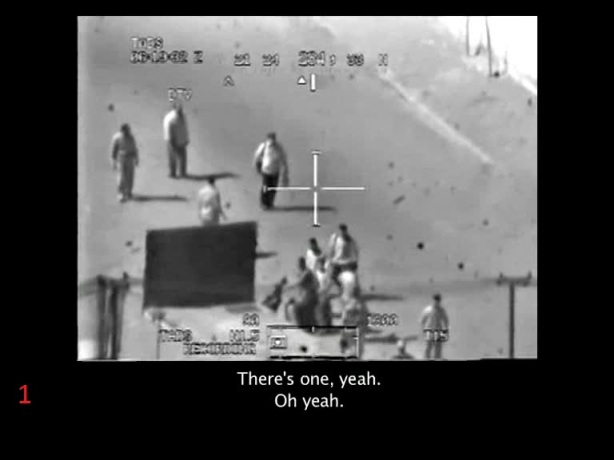
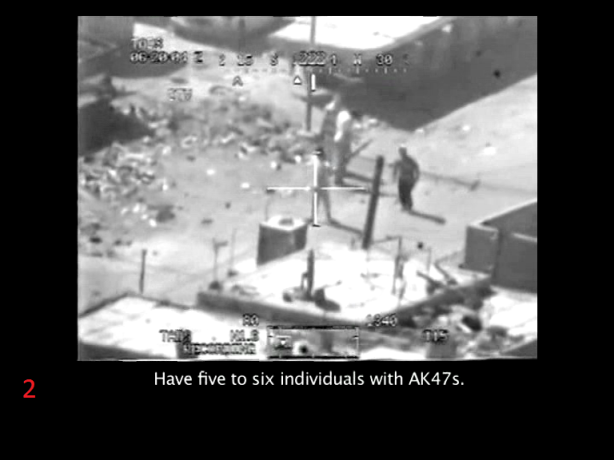
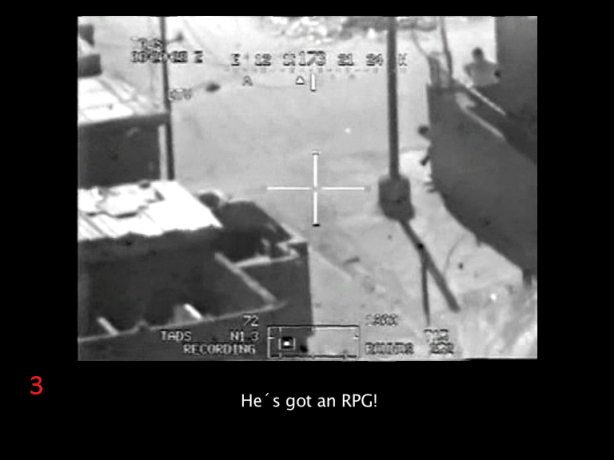
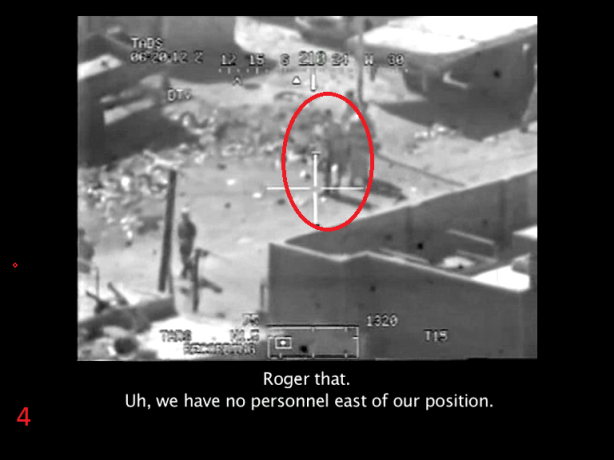
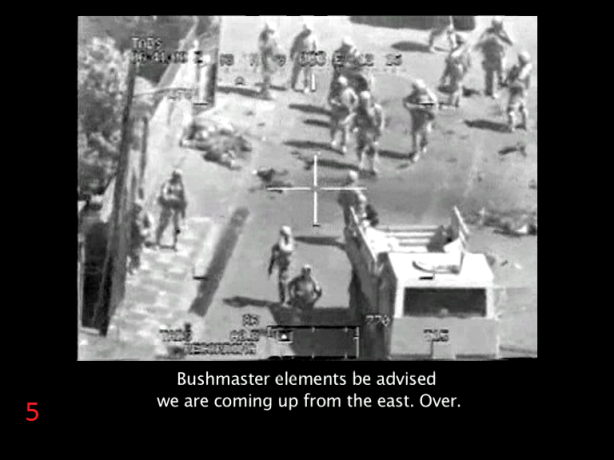
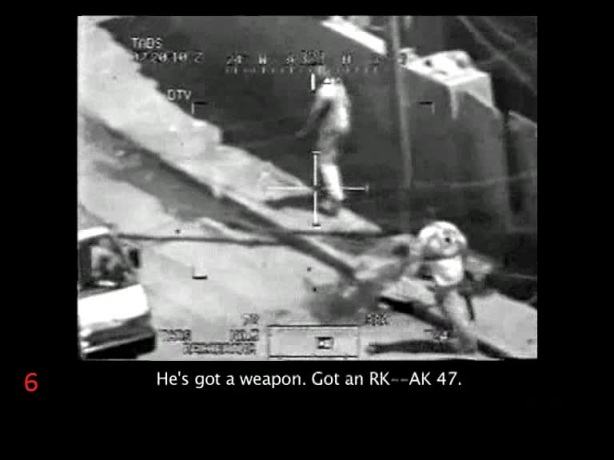
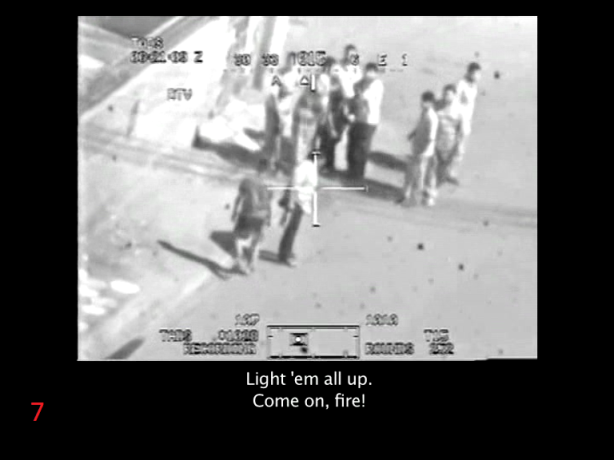
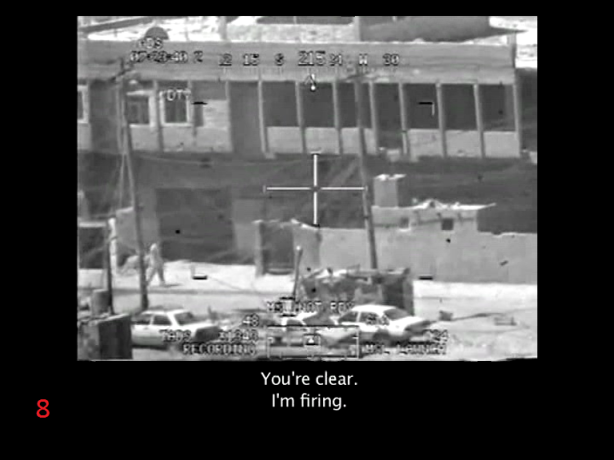
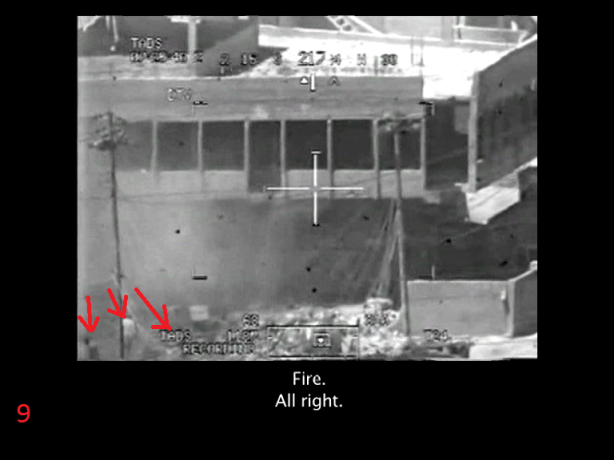
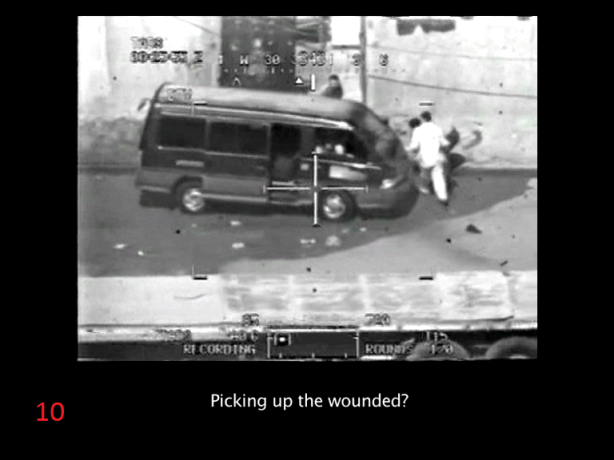
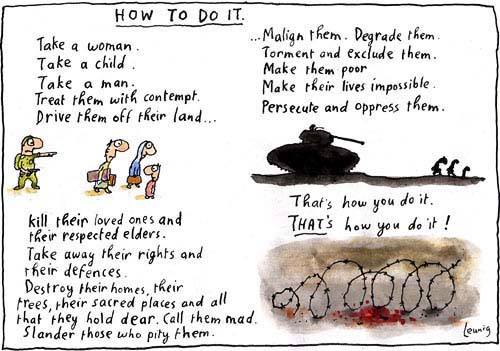

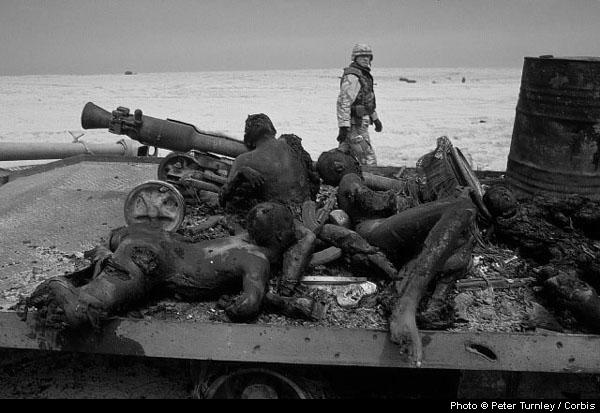
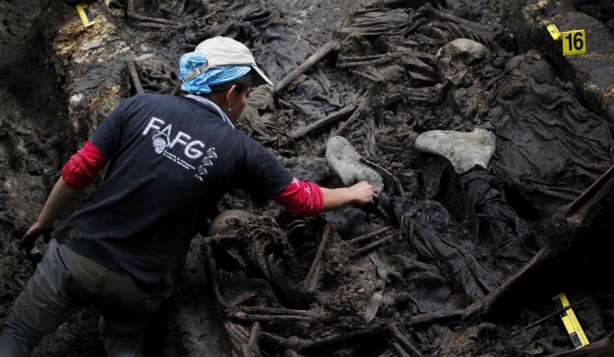
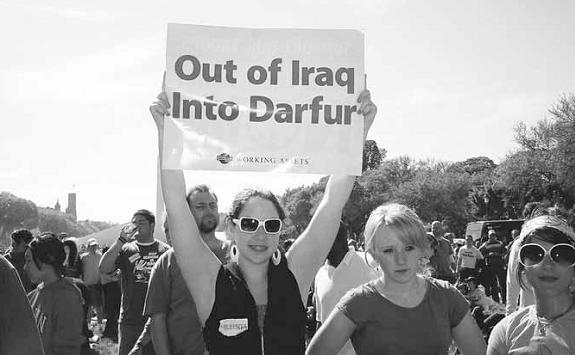
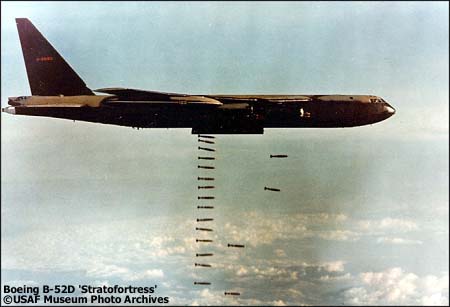
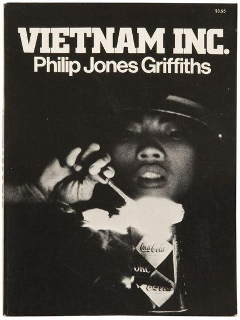
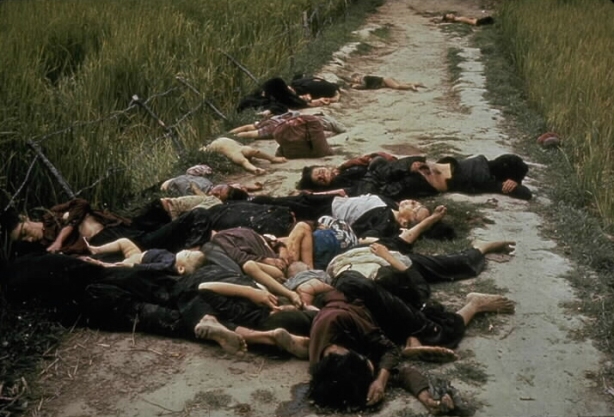
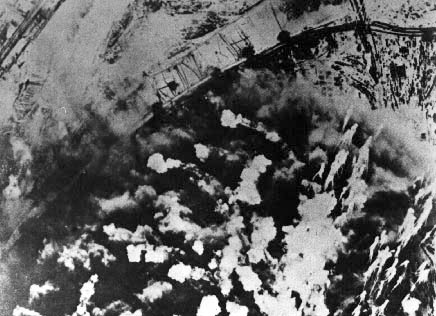







 John Foster Dulles peers across the 38th parallel.
John Foster Dulles peers across the 38th parallel.
